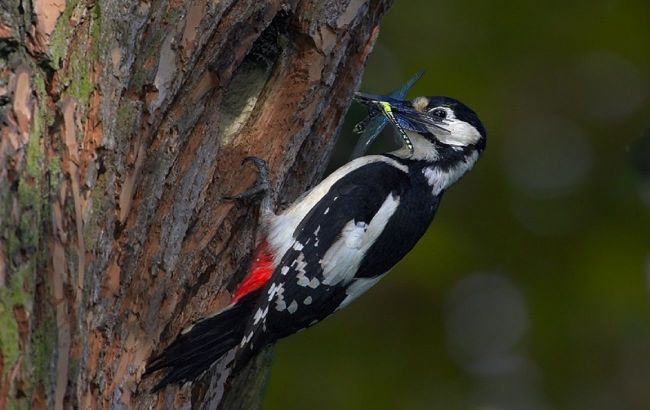Top 5 amazing things that make woodpeckers unique
 Amazing capabilities of woodpeckers (photo: Wikipedia)
Amazing capabilities of woodpeckers (photo: Wikipedia)
Woodpeckers are one of the most interesting birds in nature, which never stop to amaze with their remarkable features. RBC-Ukraine has compiled a list of 5 amazing facts about woodpeckers that demonstrate their uniqueness.
Prevention of traumatic brain injuries
Woodpeckers strike trees with their heads many times each day. They can hit a tree trunk up to 100 times per minute at a speed of 24 km/h, equivalent to a person continuously running into a tree with their face. Despite such loads, woodpeckers avoid injuries and can live for over ten years.
Researchers have identified three main reasons why woodpeckers don't suffer brain injuries:
- Powerful neck muscles
- A flexible spine
- A protective bone
Additionally, woodpecker beaks vary in length, which reduces the transmission of impact forces, and some skull bones have a spongy structure that distributes the load. Together, these features protect woodpeckers from injury during their work.
Woodpeckers have sharp spines on their tails
Woodpeckers have strong bodies and can climb trees well. Their tails have sharp spines that help them grip the bark tightly, like a third leg. When a woodpecker pecks a tree to find food or make a nest, it uses its tail for stability.
The spines on the tail, along with the claws, help the woodpecker hold securely onto the tree trunk and prevent falling, even when in awkward positions. The woodpecker's tail is particularly noticeable when spread out like a fan with sharp tips.
Relationship between woodpeckers and hummingbirds
In the forests of North America, four species of woodpeckers - Williamson's, yellow-bellied, red-naped, and red-bellied - make small holes in tree trunks to extract sap and eat insects that gather around it. They have formed a mutually beneficial partnership with hummingbirds. While woodpeckers drill holes, hummingbirds follow them to feed on the sap.
Hummingbirds protect these food sources by driving away larger birds trying to enjoy the sap, ensuring food availability for themselves and the woodpeckers. For hummingbirds, sap is an important source of nutrients, especially in spring when flower nectar may be scarce.
Cactus experts
Woodpeckers living in the deserts of the USA and Mexico use saguaros, giant cacti reaching 13 meters in height and 3 meters in diameter, as a source of food and shelter. These birds, about 25 centimeters long, have brown plumage with bright backs and red accents on their faces. They feed not only on insects but also on cactus fruits and berries.
The thick beak of this woodpecker helps maintain the health of saguaros by removing pests and damaged tissue, promoting cactus healing. Each year they excavate new nests, and the abandoned cavities become refuges for other animals, mostly rodents and reptiles.
Protection from sawdust and chips
Woodpeckers have several unique adaptations that help them withstand the intense impacts when pecking trees. Besides their tails that act as a support and shock-absorbing skulls, they have bristles or soft feathers around their nostrils to protect against dust and debris. Special air sacs filter dust that enters the nostrils.
The smallest North American woodpecker, measuring 15 cm, has large nasal bristles. This black-and-white bird, with a red spot on the nape of the male, is found from Florida to Alaska.
Another feature of woodpeckers is a translucent third eyelid, or "nictitating membrane," which closes just before impact, protecting the eyes from sawdust and debris and cleaning them during motion.

